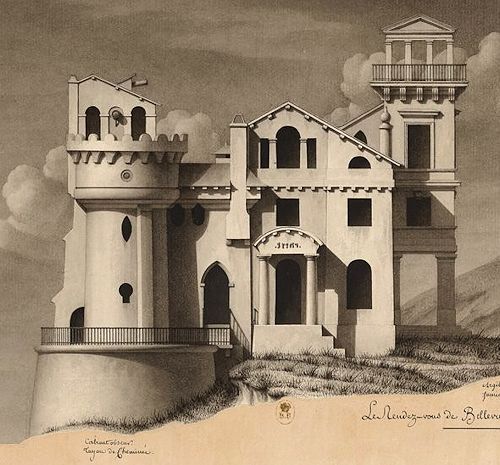| |
Jean Jacques Lequeu The rendezvous of Bellevue is on the tip of the rock 1777
But perhaps the most radical modification of the classical system of architectural figures is found in the work of the "visionary architects" of the French Revolution, Ledoux, Boullée, and Lequeu. These architects no longer believe that, as was the case in the Renaissance, the architectural figure corresponded to a hidden reality, revealed through Biblical or classical authority. Nonetheless they continued to use the Greco-Roman repertoire, whose meanings were seen to be established by social custom. But although they operated within a conceptual system inherited from the Renaissance according to which figures had metaphorical properties, they combined the traditional elements in a new way and were thus able to extend and modify classical meanings. The design of Lequeu called "Le Rendezvous de Bellevue" is an amalgam of quotations taken from different styles and organized according to 'pituresque' principles of composition. This building is a sort of bricolage made from figural fragments which are still recognizable whatever the degree of distortion. The case of Lequeu is perhaps different from that of Boullée or Ledoux because in his work classical composition seems often to be entirely abandoned. But even in an architecture based on picturesque principles, whose evident aim is to shock, the ability to provide this shock is dependent on the existence of traditional figures. One can , therefore, say of the work of all the visionary architects that it is not only an architecture parlante but lso an architecture qui parle de soi même. It consciously manipulates an existing code, even though in the case of Lequeu, it fragments this code. Emil Kaufmann and others have interpreted the work of Boullée, Ledoux, and Lequeu as being prophetic of the formal and abstrct tendencies in the new architecture of the 1920s and 1930s, and in particular the work of Le Corbusier. I prefer to see it as presenting a parallel to the present-day problem of the survival and reinterpretation of the figure of the rhetorical tradition.
Alan Colquhoun, "Form and Figure" in Oppositions 12 (1979), pp. 31-2.
| |
|
